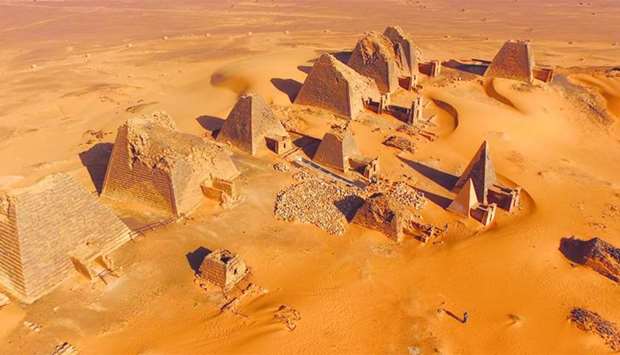The Qatari Mission for the Pyramids of Sudan (QMPS) has re-opened the burial chamber of Pyramid 9 in Meroe, Qatar Museums (QM) has announced.
The QMPS is one of the 42 missions supported by QM, under the auspices of the Qatar Sudan Archaeological Project (QSAP).
QM noted that the re-opening of the tomb, located 10m deep under King Adikhalamani’s Pyramid No. 9, who ruled the Kingdom of Meroe between 207 BCE and 186 BCE, is part of the research and conservation programme of QMPS.
Such programme was designed to preserve and investigate more than 100 pyramids in the royal cemeteries at Meroe by a team of international experts.
Conservation and security measures are planned to keep the historically important site open for the public.
“Sudan’s rich cultural heritage deserves attention and QM has a commitment and interest in celebrating and preserving cultural history, heritage and traditions and putting people in touch with their past,” QM’s acting chief archaeology officer, professor Thomas Leisten said.
“We have had a very successful five years with QSAP helping to build the knowledge and material infrastructure to sustain the country’s heritage and are looking forward to further accomplishments in the remaining years of the initiative,” he noted.
Four centuries after their ancestors ruled Egypt as the "Black Pharaohs" of the 25th Dynasty during the 7th century BCE, the Kings and Queens of Meroe created a vast empire in present day Sudan.



Recording of the archaeological finds


The centre of this kingdom was its capital at Meroe, situated about 200 km north of present-day Khartoum.
The tomb was previously excavated by George Reisner of the Boston Museum of Fine Arts in 1922 and data gathered from it has, therefore, been based on hand-written documentation to this day.
The re-excavation of the tomb and the careful and arduous stabilisation of its entrance shaft as well as adjacent structures now allows for thorough documentation, using state-of-the-art technologies that will serve as a basis for ongoing and future archaeological research.
In addition to this, a large amount of ceramics which had been left by Reisner after the original excavation were now recovered.
The recent research activities at Meroe are part of a large-scale programme that aims to investigate, preserve and promote the remarkable royal pyramid necropolises of the UNESCO World Heritage site of Meroe. It was initiated by QMPS in close cooperation with the Sudanese National Cooperation of Antiquities and Museums and the German Archaeological Institute in Berlin.
Under the QSAP umbrella more broadly, Qatar, represented by QM, provided more than $50mn in financial support for the archaeological missions working in Sudan since 2012.
This unprecedented investment enabled dramatic change in the way research, preservation and education are carried out around Sudan’s historical landmarks.
As part of QSAP, QM is currently funding 42 missions from 25 institutions and 12 countries involved in the excavation and conservation of heritage sites that date from the prehistoric era until the pre-modern period.
As a result of the funding offered by QSAP, local and international missions are able to work for several months, recruiting additional experts and using innovative and cutting-edge technologies, including 3D modelling, photography and sophisticated anthropological survey techniques.
All these activities are supported by the dissemination of research results, the digitisation and cataloguing of archival documents that have not previously been accessible to researchers in Sudan and universities abroad, and the presentation of information to the general public, including university students, to build local capacity in Sudan.
“Led by Sudan and Qatar, QSAP has been designed from the start as an international project which brings together missions made up of world-leading experts from a variety of institutions to collaborate and support one another,” professor Leisten said. “
“To date, the project has had significant impact on the developments of Sudan’s heritage sector and unearthed some incredible finds, which we look forward to showcasing,” added professor Leisten.

